
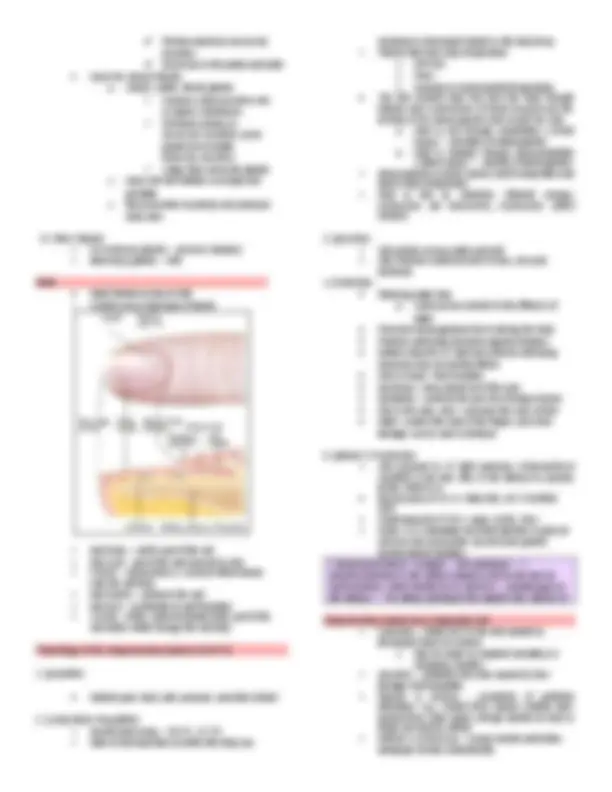
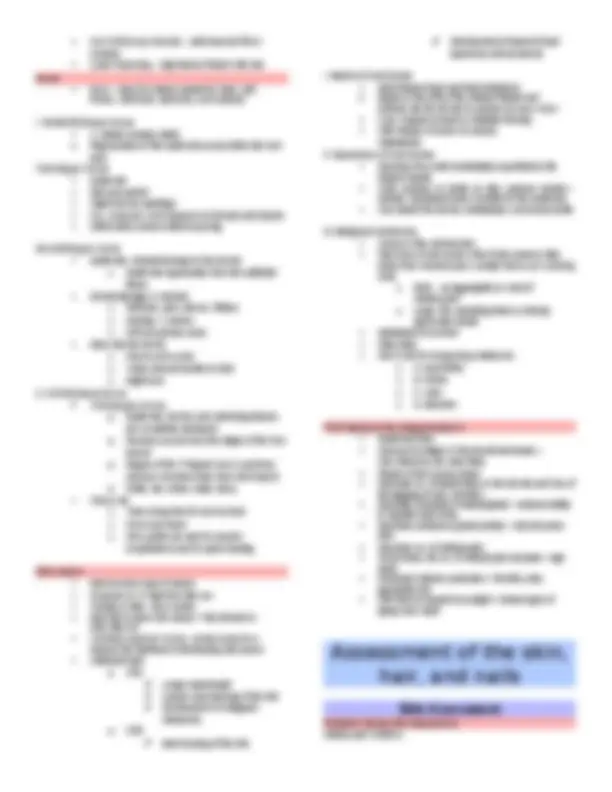
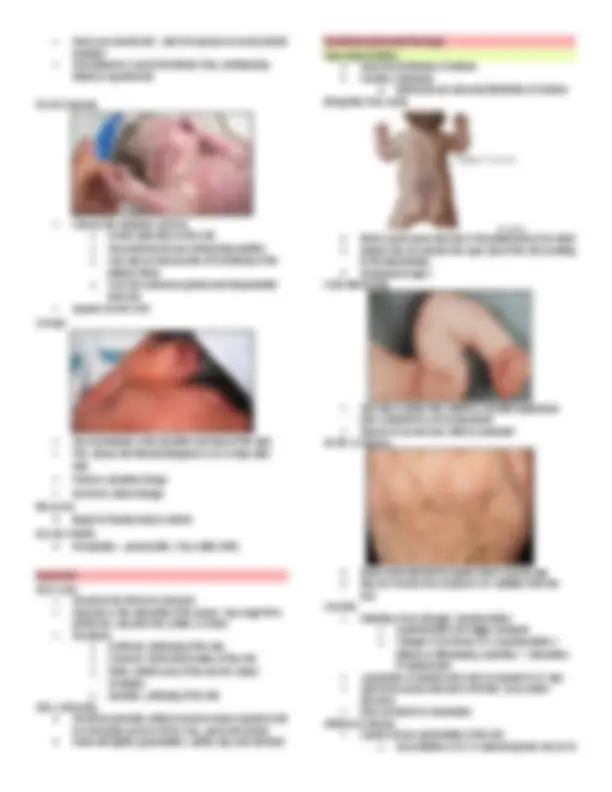
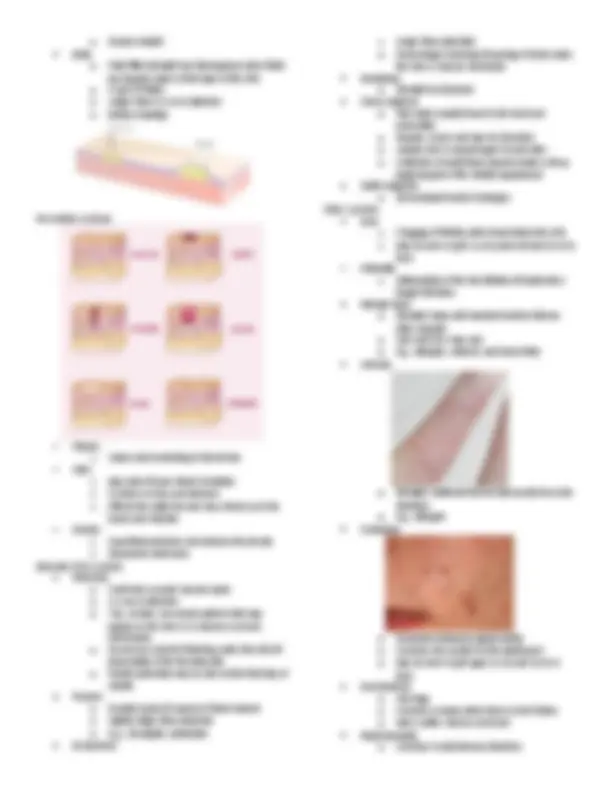
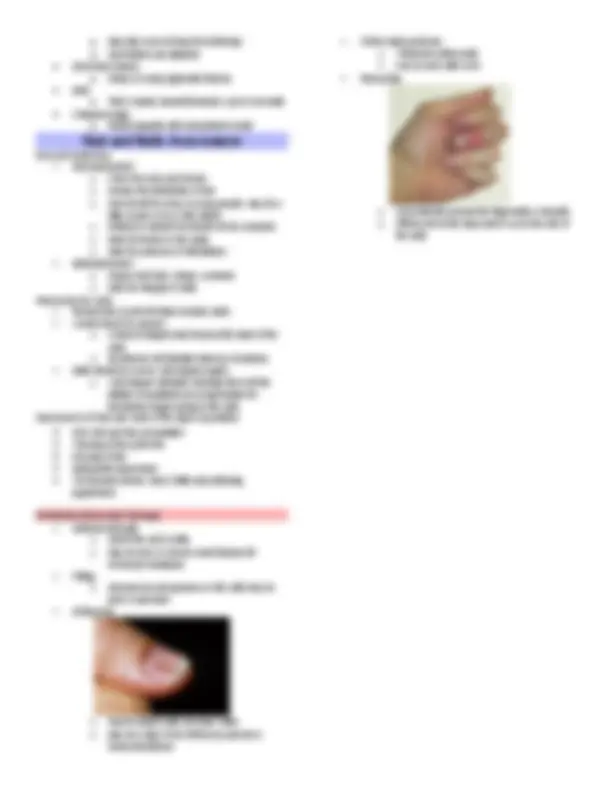


Study with the several resources on Docsity

Earn points by helping other students or get them with a premium plan


Prepare for your exams
Study with the several resources on Docsity

Earn points to download
Earn points by helping other students or get them with a premium plan
Community
Ask the community for help and clear up your study doubts
Discover the best universities in your country according to Docsity users
Free resources
Download our free guides on studying techniques, anxiety management strategies, and thesis advice from Docsity tutors
Skin, hair, and nails are made of similar types of cells. They form the outer layer of the body, called the integumentary (in-teh-gyoo-MEN-tah-ree) system. It protects everything inside the body.
Typology: Study notes
1 / 9

This page cannot be seen from the preview
Don't miss anything!






Functions of the Integumentary S. (STEP V) ▪ It consists of the skin , and accessory structures such as hair, glands, and nails.
epidermis with nutrients, remove waste products, and regulate body temperature The dermal papillae in the palms of the hands and soles of the feet are arranged in definite patterns that form looped ridges in the epidermal surface (fingerprints and footprints) These ridges increase friction and enhance the grasping or gripping ability of the hands and feet
3. Subcutaneous Tissue/ Hypodermis Attaches the skin to underlying bones and muscles Also called the hypodermis Loose connective tissue o Storage of our body’s fat (padding, insulation) o Fat in this layer functions as padding and insulation Skin Color Melanin – pigments responsible for skin, hair, eye color o It is also a protective pigment Melanin pigments – yellow (Caucasian), brown (Asians), black (African) Melanocytes – produce melanin; irregularly shaped cells; found mainly in the stratum basale Melanosomes – vesicles derived from the golgi apparatus where melanin is produced o Packed melanin Factors of Melanin Production o Genetic factors o Exposure to UV light (e.g., exposure to UV light increases melanin production as a protective mechanism→ suntanned) o Hormones (e.g., estrogen and melanocyte- stimulating hormone (MSH) results to an increase production of melanin during pregnancy→ chloasma “mask of pregnancy”) Albinism - recessive genetic trait that causes deficiency / absence of melanin Cyanosis - bluish skin color; decreased blood O Carotene – yellow pigment in plants (squash, carrots); source of vitamin A o Lipid-soluble and if taken in excessive amounts, the skin may turn yellowish Birthmarks – congenital disorder of the capillaries in the dermis (dilation of the capillaries e.g., strawberry hemangiomas) Accessory Skin Structure Hair Columns of dead, keratinized epithelial cells
Hair follicle – where each hair rises o Can play an important role in skin repair o If the surface epidermis is damaged, the epithelial cells within the follicle can divide and become a source of new cells Shaft – above the skin Root – below the skin Hair bulb – site of hair cell formation; “growth zone” o Where distribution of melanocytes occurs Hair papilla- where hair bulb rests; supplies hair bulb with blood and nourishment needed to produce hair Cortex – hard keratin, covering of the central core Medulla – soft central core Cuticle – single layer of overlapping cells that holds the hair in the hair follicle; heaviest keratinized region and outermost layer of hairs Growth Stage Hair is formed by epithelial cells within the hair bulb Divide and undergo keratinization Hair root + shaft = columns of dead keratinized epithelial cells Resting Stage Growth stops Hair is held in the hair follicle Next growth stage A new hair is formed The old hair falls out Eyelashes – grow for about 30 days; rest for 105 days Scalp hairs – grow for 3 years; rest for 1 – 2 years Arrector Pili – smooth muscles associated with every hair follicle; contraction = hair to stand more perpendicular to the skin’s surface ; produces goose bumps Glands I. Sebaceous Glands Simple, branched acinar glands (sac-like) Connected by a duct to the superficial part of the hair follicle Sebum – oily, white substance rich in lipids; released by holocrine secretion; lubricates the hair/surface of the skin (prevents drying and protects against bacteria) White heads- blockage of the sebaceous glands Blackheads - accumulated material which oxidizes, dries and then darkens Acne- infection of the sebaceous glands Seborrhea or seborrheic dermatitis- “cradle cap” in infants – it is caused by the overactivity of the sebaceous glands II. Sweat Glands Sweat- clear secretion (produced by the sweat glands) that is primarily water, salts, vitamin C and it may contain traces of metabolic wastes and lactic acid Eccrine Sweat Glands o Simple, coiled, tubular glands located in almost every part of the skin
Iron Deficiency Anemia – nails become flat or concave Lead Poisoning – high levels of lead in the hair Burns Burn – injury to a tissue caused by heat, cold, friction, chemicals, electricity, and radiation I. Partial-thickness Burns S. basale remains viable Regeneration of the epidermis occurs within the burn area First-degree burns Epidermis Red and painful Slight edema (swelling) E.g., sunburns, brief exposure to hot and cold objects Heals within a week without scarring Second-degree burns Epidermis, minimal damage to the dermis o Epidermis regenerates from the epithelial tissue Dermal damage is minimal o Redness, pain, edema, blisters o Healing = 2 weeks o Will not produce scars Deep into the dermis o Pink to red in color o Takes several months to heal o Might scar II. Full-thickness Burns Third-degree burns o Epidermis, dermis, and underlying tissues are completely destroyed o Recovery occurs from the edges of the burn wound o Region of the 3rd^ degree burn is painless (sensory receptors have been destroyed ) o White, tan, brown, black, deep Cherry red o Take a long time for burn to heal o Form scar tissue o Skin grafts are used to prevent complications and to speed healing Skin Cancer Most common type of cancer Exposure to UV light from the sun Usually on face, neck, hands Most like to have skin cancer = fair skinned or older than 50 Limiting exposure to sun, using sunscreen; reduces the likelihood of developing skin cancer Ultraviolet light o UVA Longer wavelength Causes most tanning of the skin Development of malignant melanoma o UVB Most burning of the skin Development of basal cell and squamous cell carcinoma I. Basal cell carcinoma Most frequent type and least malignant Begins in the cells of the stratum basale and extends into the dermis to produce an open ulcer Cure; surgical removal or radiation therapy Little danger of cancer to spread, metastasize II. Squamous cell carcinoma Develops from cells immediately superficial to the stratum basale Cells continue to divide as they produce keratin→ nodular, keratinized tumor confined to the epidermis Can invade the dermis, metastasize, and cause death III. Malignant melanoma Cancer of the melanocytes Rare form of skin cancer (5% of skin cancers) that arises from melanocytes ; usually from a pre-existing mole o Mole – an aggregation or nest of melanocytes o Large, flat, spreading lesion or deeply pigmented nodule Metastasis is common Often fatal ABCD rule for recognizing melanoma: o A- asymmetry o B- border o C- color o D- diameter FX of Aging on the Integumentary S. Epidermis thins Amount of collagen in the dermis decreases ▪ Skin infections are most likely Repair of skin occurs slower Decrease no. of elastic fibers in the dermis and loss of fat (sagging of skin, wrinkles) Decrease of activity of sweat glands = reduced ability to regulate body temp. Decrease sebaceous gland activity = skin becomes drier Decrease no. of melanocytes Some areas, the no. of melanocytes increase = age spots Increased melanin production = freckles; also, gray/white hair Skin that is exposed to sunlight = shows signs of aging more rapid
Pediatric Clients Skin Assessment Infants and Children
Have very smooth skin – lack of exposure to environmental variables Subcutaneous is poorly developed, thus, predisposing infants to hypothermia Vernix Caseosa Cheese-like substance (sebum) o Avoids maceration of the skin o Has antimicrobial and moisturizing qualities o Also aids as heat insulator d/t immaturity of the adipose tissue o From the sebaceous glands and desquamated fetal skin Appears 20 wks AOG Lanugo Seen abundantly in the shoulders and back of the baby Fine, downy hair that will disappear in 10-15 days after birth Preterm- abundant lanugo Post term- absent lanugo Merocrine Begins to function about 4 weeks Eccrine Glands Perspiration – present after 1 hour (after birth) Inspection Skin Color Should be the first to be observed Depends on the nationality of the person, may range from pinkish tan, rudy dark red, yellow, or brown Deviations o Erythema- reddening of the skin o Cyanosis- bluish discoloration of the skin o Pallor- whitish color of the skin d/t ↓blood circulation o Jaundice- yellowing of the skin Skin Uniformity Should be generally uniform except in areas exposed to the sun and areas prone to friction (e.g., groin and armpit) Areas with lighter pigmentation—palms, lips, and nail beds Deviations (abnormal findings) Hyperpigmentation Abnormal distribution of melanin Freckles, birthmarks o Birthmarks are abnormal distribution of melanin Mongolian blue spots Bluish purple spots observed in the gluteal area of an infant Melanin has not reached the upper part of the skin resulting to this discoloration Disappears at age 1 Cutis Marmorata Skin has a pinkish blue mottled or marbled appearance when subjected to cold temperatures Returns to normal once infant is rewarmed Senile Lentigines Brown spots that start to appear when a person age May be a result of sun exposure (UV radiation from the sun) Freckles Indication of sun damage, hypothyroidism o Hypothyroidism can trigger melasma o Changes in hormones if (+) hypothyroidism→ effects on inflammatory cytokines→ stimulation of melanocytes ↑production of melanin when skin is exposed to UV rays Light brown spots observed in the face, neck, and/or shoulders More prominent in Caucasians Addison’s disease Causes bronze pigmentation of the skin o Accumulation of ACTH (adrenal glands may be to
Lesions arranged in a line Pedunculated lesions Benign tumors usually less than 1 cm and has its own blood vessels Size Measure in centimeters using a ruler Location and distribution Note the area, region, extremity it is found Note for exudates (color) Gently scape a scale on a lesion to see if it comes off or bleeds, if it comes to perform the lesion blanching test Tumbler Test To check if a lesion is blanchable or not o Meningitis and herpes zoster/ shingles are non- blanchable lesions Herpes zoster lesions never cross the midline because the spinal nerves are not connected o Lies dormant in the dorsal root ganglia A non-blanchable erythema may be indicative of pressure ulcer or bed sores Types of Lesions Primary Lesions Macule o Flat, cannot be palpated, color may range from brown, white, tan, purple, and red o Less than 1 cm with a circumscribed border o Café au lait Papule o Small and elevated o Containing solid mass o Circumscribed border and are less than 0.5 cm Plaque o Slightly elevated, scale-like lesion o >0.5 cm to 1cm in diameter o Psoriasis Pustule o Puss-filled (purulent) vesicle or bulla o Erythema toxicum neonatorum and acne Nodule o May feels like large pea under the skin o Circumscribed, elevated solid lesion with depth up to 0.5-2 cm e.g., cyst Cyst o Non-cancerous, closed pockets of tissue that can be filled with fluid, pus, or other material that may extend to the subcutaneous layer o Can develop as a result of infection, clogging of sebaceous glands, or around foreign bodies such as earrings Tumor o Common as people get older o Larger than a nodule o Seborrheic keratosis is an example of common benign tumors Vesicles o Small, fluid-filled sacs o Fluid inside may be clear, white, yellow, or mixed with blood o Less than 0.5 cm in diameter
o Herpes simplex Bulla o Fluid-filled elevated sac that appears when fluids are trapped under a think layer of the skin o A type of blister o Largen than 0.5 cm in diameter o Bullous impetigo Secondary Lesions Fissure o Linear crack extending to the dermis Ulcer o May arise d/t poor blood circulation o Common in bony prominences o Affects the epidermis and may extend up to the bones and muscles Erosion o Superficial and does not extend to the dermis o Depressed moist area Vascular Skin Lesions Petechiae o Small red or purple macular spots o 1-2 mm in diameter o Tiny, circular, non-raised patches that may appear on the skin or in mucous or serous membranes o Occurs as a result of bleeding under the skin d/t abnormality of the thrombocytes o Pinkish petechiae may be seen at the third day of rubella Purpura o Purplish spots d/t rupture of blood vessels o Slightly larger than petechiae o E.g., meningitis, snakebites Ecchymosis o Larger than petechiae o Hemorrhagic blotching d/t pooling of blood under the skin or mucous membrane Hematoma o Elevated ecchymosis Cherry angioma o Red moles usually found in the trunk and extremities o Papular, round, and may be blanched; o Usually seen in people aged 10 and older o Collection of small blood vessels inside a cherry angioma gives it the reddish appearance Spider angioma o D/t increased levels of estrogen Other Lesions Acne o Clogging of follicles with oil and dead skin cells o May be seen in girls 14-16 years old and 16-19 in boys Folliculitis o Inflammation of the hair follicles d/t bacterial or fungal infections Wheals/ hives o Elevated mass with transient borders that are often irregular o Size and color may vary o E.g., allergies, urticaria, and insect bites Urticaria o Elevated, reddened lesions that results from skin reactions o E.g., allergies Comedone o Increased sebaceous gland activity o Common skin problem of the adolescent o May be seen in girls ages 14-16 and 16-19 in boys Acrochordons o Skin tags o Common in areas where there is skin friction o Neck, axillar, cheeks, and trunk Alopecia areata o Common in autoimmune disorders